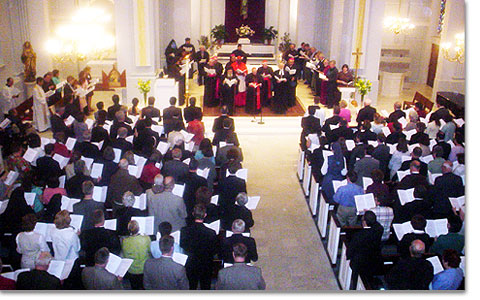 |
Jornada por la paz en Washington: Oracion de los cristianos Journey for peace in Washington: Prayer of the Christians Interreligiöses Friedensgebet in Washington: Gebet der Christen |
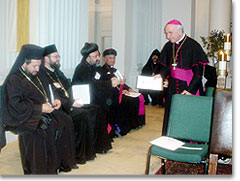 |
|
Obispos cristianos Christian bishops Christliche Bischöfe |
|
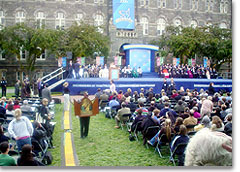 |
|
Un momento de la Jornada A moment of the journey Momentaufnahme, Campus |
|
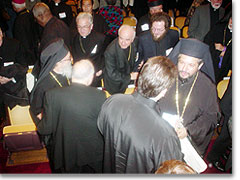 |
|
Los líderes religiosos dialogan Religious leaders in dialogue Religionsführer im Dialog |
|
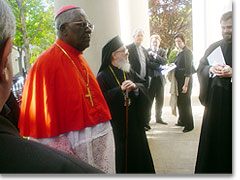 |
|
Momentos de intercambio Moments of encounter and sharing Augenblicke der Begegnung und des Austauschs |
|
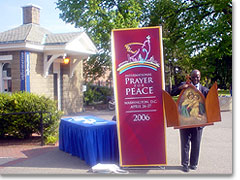 |
|
La familia de Schoenstatt de Washington participó The Schoenstatt Family of Washington participated Für die Schönstatt-Familie von Washington war die Teilnahme eine große Freude Fotos: Soros © 2006 |
|
|
USA, Enrique Soros. "Dialogue is an art. It is not a choice for the faint-hearted, of those who allow evil to play out without a struggle. Dialogue demands that each man and woman see the best in others and to affirm the best in oneself". This message is part of the document "A Call for Peace", that was signed by international leaders of many creeds, who gathered on April 26th and 27th, on the grounds of Georgetown University in Washington, DC, within the framework of the International Journey of Prayer for Peace for the year 2006.
In 1986 Pope John Paul II convoked the religious leaders of the world to a journey for world peace. It was held in Asia. Thousands of religious leaders attended to pray together. The Pope asked that these encounters continue, and the Catholic movement San'Egidio decided to have an annual world-wide convocation. Among other places , in 1987 the journey was held in Rome, in 1989 in Warsaw, in 1991 in Malta, in 1993 in Milan, in 2000 in Lisbon, in 2001 in Barcelona, in 2003 in Aachen, Germany…This year, for the first time, the encounter took place in the United States, and it consisted of two days of talks, debates and prayer.
We respond to death with dialogue
The first day, Wednesday, April 26th, among others, presentations were made by Cardinal Theodore McCarrick, Archbishop of Washington and the professor Andres Ricaardi, founder of the San Egidio Community, who mentioned that "the biggest terrorist of the world, affirmed: << we respond to dialogue with death>>, but we, respond to death with dialogue", a phrase that merited a sustained applause from the audience.
Three religious leaders participated in a panel with the topic "People of faith and of courage to dialogue". The protagonists were: Iman Warith Mohammed, religious minister of the United States; rabbi in chief, Shean-Yashuv Cohen, rabbi general of Haifa, Israel and Diarmuid Martin, Archbishop of the Catholic Church in Dublin, Ireland.
To go further than tolerance
Rabbi Shean-Yashuv Cohen pointed out that "we can only pray together if we respect each other and we do not try to change one another, and if there is no intent to proselytize." He concluded with a very eloquent image: "A garden has flowers of many kinds and colors. These flowers are the various people who have different religions. Together they form a wonderful garden in harmony. The gardener is God, who wants this harmony of a colorful garden."
Jean- Arnold de Clermont, president of the Conference of European Churches, touched on a key point: "I do not like to speak about tolerance. To tolerate expresses the idea of withstanding. We should go much further. As men and women of faith, we have the obligation to be in solidarity, of profoundly respecting each other, of wanting the best for others, beyond our own belief". He also mentioned that in no other part of the world is the responsibility and the means to achieve peace concentrated more than in Washington, DC.
To believe that peace and unity are possible
Thursday, the 27th, was a day of panels with different topics: Religions and pluralism in a democracy. Making poverty a thing of the past, a challenge for the world. Freedom of religion, a right that is often denied. Religions and the culture of life. Religions confronting terrorism. The media: religions, war and peace. Spiritualizing politics without politicizing religion. Prayer as a source of peace. Overcoming the crisis of HIV/aids…
"Let us close our eyes and imagine a playground. There, white children play with the blacks, Indians with the Chinese, the rich with the poor. Let us imagine how the world would be if only adults could live in this ingenuousness, with that inner freedom. We are all children of God. Let us take a chance. Let us try to live with more ingenuousness, really loving each other. May God bless you, and may he give you the madness to believe that peace and unity are possible if we do all we can", concluded Dr. Robert Edgar, Secretary General of the National Council of Churches, during the ecumenical prayer service that gathered all Christians. The other religions had their services in different places in the area.
To seek roads to peace
In a press conference, Cardinal Theodore McCarrick, Archbishop of Washington, responded to the uneasiness of the reporters. Schoenstatt asked: "Cardinal Jean-Arnold de Clermont, president of the European Conference of Churches, affirmed yesterday that no other part of the world has as much responsibility and the concentrated means to construct peace as Washington, DC. Also yesterday, during the same session, Karen Hughes, Sub-secretary of State for Diplomacy and Public Affairs of the United States, centered her message by emphasizing that religions should not favor terrorism, rather they should co-exist in peace, undoubtedly, Hughes was the person, who mentioned the scourge of terrorism more throughout the journey, but flagrantly eluded what the responsibility of the State was in constructing a world at peace. You, Cardinal McCarrick, are geographically steps away from President Bush. But do you expect him to listen to this message of peace, being that he did not listen to Pope John Paul II when he begged him not to invade Iraq?
The Cardinal’s response was optimistic, affirming that "this encounter is to pray for peace, and we well know how God listens to prayer. People from different parts of the world came here to pray, and in all parts of the world there is prayer for peace. It is important to work with religious people in favor of peace. And at the same time, we should seriously work for justice, since peace cannot exist without justice. This encounter undoubtedly encourages the rulers and the leaders and the members of the religious communities to seek common roads to peace."
The arrogance of those who think they hold all the truth, and only the truth, and they live for making it known to others
What religious person, convinced of his faith, doesn’t believe that his religion is the true one? But…is it possible to dialogue in spite of this? With many it is possible, with others who believe they are open, but wants to impose "the truth", it is not possible. "The sources may be different, or not; the syndrome same", commented William Carmon, a participant of journey that traveled from Boston. "Some base themselves on the Bible, others on the dogmas of the Church, others on the Koran. Many times intolerance disguises itself in the love of God and respect for the truth, but at the bottom, the intolerant one, who believes he is a crusader of the truth, does not understand the core message, which is love, although he may discuss until death that he does understand it. Many times we hear about religious people who claim that they want to dialogue, but they cannot listen without responding to each phrase with a counter argument. These people, who spend their life preaching and sending everyone who does not believe like them to hell would benefit from attending this encounter. They would be very upset if they heard that their attitudes are more sectarian than characteristic of a religion", William Carmon concluded by sharing with enthusiasm: "the fundamental message is that God is love." And he cited the verse of John 4, 16b by memory, he said "God is love, and he who remains in love, remains in God, and God remains in him."
My son, do you know my Mother, Mary?
"In an ecumenical encounter in Rome I began a talk commenting that when Protestants die we will go to meet Jesus, and He will say to us: <<Come, come in, I want you to meet my Mother , Mary>> In a humorous way, Jurgen Hohannesdotter, Lutheran Bishop from Schaumburg-Lippe, Germany, one of the three main celebrants of the Christian prayer service, alluded to the necessity of shedding all egoism, when dealing with unity and ecumenism, to the point of laughing at that of which we may be criticized. Throughout the two day journey, there was not the least expression of trying to convince someone that their own posture was the correct one. Rather there was an atmosphere of profound respect and in a way there was also a silence of hearts, of deep humility, as if allowing the God of love to perform his miracles of unity and peace. There is no doubt, according to the testimony of the participants, that he performed them, and performed them abundantly.
Translation: Celina Garza, Harlingen, TX, USA